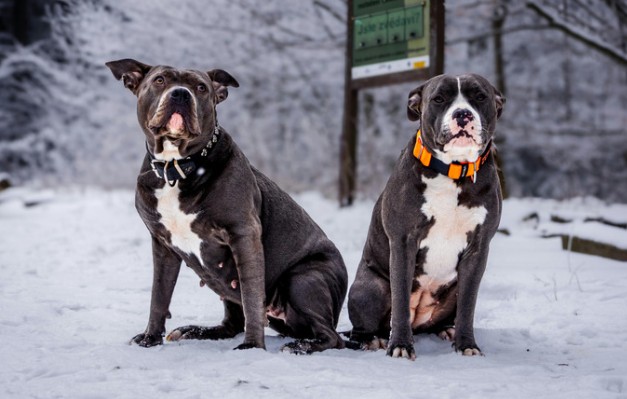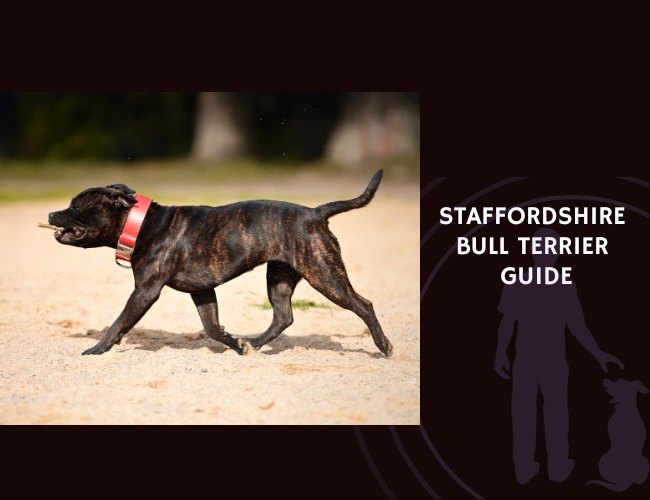Introduction to the Staffordshire Bull Terrier
A Brief Look at the Breed
The Staffordshire Bull Terrier, often called the “Staffie,” is a medium-sized dog packed with personality and heart. Known for their strong, athletic look and that famous smile, Staffies are built with sturdy muscles and a compact frame. In a professional setting, recognizing both their physical and emotional traits helps set realistic expectations for families looking for an affectionate, loyal companion.
Roots in 19th-Century Britain
Staffordshire bull terriers trace their beginnings back to 19th-century Britain. At that time, the breed was created by crossing bulldogs with terriers. The goal was to combine strength and courage with agility and tenacity. Unfortunately, these dogs were first bred for cruel sports like bull-baiting, which required extreme toughness and bravery.
When those sports were banned, the Staffie’s future changed for the better. Supportive families and breeders recognized the dog’s big heart, and these qualities soon made them beloved pets instead of working animals. Over generations, careful breeding focused on developing calmness and companionship, transforming the Staffie into a gentle, people-oriented breed known for bonding deeply with its humans. Today, most Staffies are best known as loving additions to households, far removed from their rough beginnings. 🐾
Understanding the Myth and the Reality
Despite their sweet disposition, Staffies have sometimes suffered from misunderstood reputations. People often mistake them for aggressive or unpredictable dogs. However, this is a misconception. In reality, Staffies are renowned for being wonderfully affectionate with people, especially children. This has earned them the nickname “nanny dog” for their loyalty and gentle nature toward kids.
When properly raised and trained, Staffies are happy, curious, and eager to please. They thrive on positive human contact and want to be part of the family’s daily activities. Far from being naturally aggressive, their true temperament is warm, goofy, and always up for a cuddle. Like all breeds, they require early socialization and thoughtful training to ensure their best behavior, but aggression is not a characteristic of a well-cared-for Staffie.
Learning more about what makes the Staffordshire bull terrier special sets the stage for understanding their temperament and needs at home.
Character and Behavioral Traits
Physical strength and resilience
Staffordshire bull terriers, or Staffies, are best known for their sturdy, muscular bodies and thick necks. Their historical roots as bull-baiting dogs from 19th-century Britain have gifted them with a striking appearance. This muscular build not only gives the Staffie impressive strength for its size but also contributes to a notable resilience. Many owners notice that Staffies have a high tolerance for pain. While this trait was useful in their past, today it’s simply a sign of their hardiness and tenacity.
Big-hearted affection—especially for kids
Despite their tough exterior, Staffies are affectionate, loving, and thrive on close human contact. The nickname “nanny dog” comes from their natural fondness for children and desire to be part of family life. When raised in stable homes, this breed is known for showing deep loyalty and emotional exuberance. Staffies are happiest when surrounded by their people, often following them from room to room so they never miss a moment together. It’s not unusual for a Staffie to curl up beside their favorite child or enthusiastically join family activities. Their goofy, cuddly ways quickly win hearts.
Social challenges and behavioral vulnerabilities
Although Staffies adore people, their interactions with other dogs can be more complicated. They generally have low social adaptability, especially with unfamiliar dogs or dogs of the same sex. This means that Staffies may show reactivity or unease when meeting new canine companions 🐕. Proper training and early socialization can reduce conflict, but it’s not uncommon for Staffies to prefer the company of humans over that of other dogs.
Behavioral vulnerabilities, like overexcitement and barrier frustration, are not rare in the breed. High emotional arousal can lead to jumping, pulling on the leash, or vocalizing when boundaries are unclear. Their determination—amazing when channeled into play or positive activity—can also result in unwanted behaviors if boredom or frustration set in. Early intervention, patient guidance, and structured routines can help Staffies learn how to express themselves in positive ways.
Staffies are a blend of brawn, loyalty, and joy, making them treasured companions for those who understand their needs. With their affectionate spirit and sturdy resolve, understanding them is the first step to a lasting bond ❤️.
Transitioning from understanding Staffie character, we next focus on how positive training can unlock your Staffie’s best self.
Training and Socialization
Positive Reinforcement for Staffies
Training a Staffordshire Bull Terrier (Staffie) is all about creating a positive, rewarding experience 😁. In a professional setting, trainers rely on positive reinforcement, which means using treats, toys, or praise to encourage good behavior. Staffies are famous for their strong food and play drives, making these rewards very motivating. Instead of harsh corrections, focus on what your dog does right. Toss a treat whenever your Staffie sits calmly, pays attention to you, or responds to a cue. Toys also work wonders because play is just as valuable as food for many Staffies.
During daily practice, keep training sessions short and fun. This approach builds a supportive bond between you and your dog, which leads to better learning and trust. Staffies thrive on high-engagement routines that mix clear boundaries with exciting challenges. Steer clear of punishment-based training, as it might lead to fear or even aggression, especially in sensitive breeds like the Staffie.
The Power of Early Socialization
To support our customers who welcome Staffies into their homes, we recommend starting socialization as early as possible. Socialization helps puppies learn that new people, animals, and environments are not scary but fun and rewarding. Early exposure reduces the chances of fear-based behaviors or aggression toward other dogs.
Structured socialization should include supervised interactions with calm, friendly dogs and various people. This method is especially important to prevent Staffies from developing dog-directed aggression, a known breed vulnerability. Introduce your puppy to different sights, sounds, and experiences in a positive way—bring treats and let your pup go at their own pace. Early, gentle exposure sets them up for success with new situations throughout life.

Key Focus Areas for Training
Impulse Control
Many Staffies are exuberant by nature. Teaching impulse control—like waiting at doors, sitting for attention, or taking treats gently—can prevent problems before they start. Start simple, reward patience, and always praise good choices.
Handler Focus
Building strong focus on the handler means your Staffie pays attention to you, even around distractions. Use their favorite treats or toys to make eye contact games a daily routine. This foundation keeps you both connected, inside and outside the home.
Calm Greetings
Staffies are super affectionate, but that sometimes means they jump or get overexcited when meeting people. Teach calm greeting behaviors by rewarding sitting or keeping all four paws on the floor when friends arrive. Consistency and clear expectations help your Staffie shine as a well-mannered companion.
With a foundation of positive reinforcement, early socialization, and a focus on impulse control and engagement, your Staffie can grow into a confident, friendly adult. Next, let’s look at what keeps their bodies healthy and strong every day.
Nutritional Requirements
Staffordshire Bull Terriers need a thoughtful diet to stay healthy and happy. Their muscular build means they benefit from good-quality protein, balanced energy, and extra attention to skin health.
Supporting a Muscular Build
One of the most informative and professional ways to support a Staffie’s physique is through a diet with balanced protein. A combination of high-quality animal proteins like chicken, lamb, or fish gives muscle tissue the building blocks it needs. Remember not to rely on just one protein source. Rotating through several helps lower the risk of food sensitivities and supports overall health.
Calorie Control for a Moderately Active Breed
Even though Staffies love a fun play session, they’re only moderately active overall. If their food intake isn’t managed, they can put on extra weight quickly. To support owners, opt for measured portions instead of free-feeding and use treats sparingly, especially as Staffies are often extra motivated by food rewards during training. Watch for changes in activity and age—older or neutered dogs may need fewer calories. Regular weigh-ins (at least once per month) help catch weight gain before it becomes a problem. 🐾
Managing Food Sensitivities and Skin Issues
Some Staffies experience food allergies or sensitivities. This can show up as itchy skin, recurring ear infections, or digestive trouble. In these cases, a limited-ingredient or hypoallergenic diet can be the most supportive path. Diets rich in omega-3 fatty acids (like those from fish oil), zinc, and antioxidants also help maintain a healthy skin barrier and shiny coat. Owners in a professional setting may find that avoiding common allergens such as beef, dairy, or wheat makes a real difference.
Try to avoid overfeeding treats, even when using positive reinforcement. High-value but low-calorie treats—like freeze-dried meats or simple fruits (in moderation)—can keep Staffies motivated without extra weight gain. Split the daily calorie allowance between meals and treats for best results.
Being attentive to nutrition has a long-term impact on the Staffie’s health and comfort. With their dietary needs met, Staffies are ready for daily adventures while keeping their signature shine inside and out.
Transitioning to concerns about health and everyday care helps ensure every Staffie’s best years are ahead.
Bold. Loyal. Unbreakable.
Steel Wrapped in Love. Staffordshire Bull Terriers are compact powerhouses wrapped in pure affection. Their muscles tell one story—but their hearts tell another. Behind the strength lies loyalty so fierce, it earns them the title of “nanny dog” and a lifetime spot beside those they love.
Joy in Every Fiber. Staffies live for laughter, play, and people. Their goofy grins, zoomie bursts, and total-body tail wags aren’t acts—they’re how this breed says “I’m all in.” Their devotion isn’t quiet—it’s loud, proud, and always leaning into your legs.



Fire with a Filter. Don’t mistake softness for weakness. Staffies are emotionally intense and physically tenacious. What they need isn’t control—it’s connection, structure, and space to thrive. When met with fairness and love, they give back everything tenfold.
Health Concerns and Preventative Care
Breed-Specific Genetic Health
A Staffordshire Bull Terrier’s (Staffie) bright personality can shine for over a decade, but supporting their health takes some planning. Staffies are prone to a few breed-specific conditions. Two of the most important are hereditary cataracts and L-2-hydroxyglutaric aciduria (L-2-HGA). Hereditary cataracts may lead to vision problems or even blindness, sometimes as early as puppyhood. L-2-HGA is a metabolic disorder that impacts the nervous system, causing tremors or unusual behavior in severe cases. Responsible breeders use genetic tests to screen for these issues, helping to create healthier puppies in each generation. If you are thinking about adopting or buying a Staffie, ask for proof that the puppy’s parents have tested clear for both hereditary cataracts and L-2-HGA. 🩺
Skin Sensitivities and Allergies
Staffies are well-loved for their glossy coats, but their skin can be a trouble spot. Skin allergies, like atopic dermatitis, are common and can cause itchiness, redness, and frequent scratching. Environmental allergens, certain foods, and even flea bites can trigger these reactions. Another concern is demodectic mange, a skin condition caused by mites. While the immune system usually keeps these mites in check, puppies or stressed dogs may develop patchy fur loss and skin infections.
At-home care often means gentle baths with vet-recommended shampoos and a close eye on any changes to the skin or coat. Omega-3 fatty acids from fish oil in their diet may help support healthy skin. Always talk to a vet if you notice anything out of the ordinary—early care is the key to relief and comfort.
General Preventative Care and Lifespan
To help keep Staffies thriving, regular health screenings are a must. Recommended checks include:
- Eye exams for early cataract signs
- Neurological assessments to rule out L-2-HGA
- Skin checks for signs of allergies or mange
Proactive care also includes vaccinations, dental cleanings, monthly flea and tick prevention, and an annual vet visit for a thorough checkup. With these steps, most Staffies enjoy a lifespan of around 12–14 years, sharing plenty of joyful moments with their families.
Supporting your Staffie’s wellbeing means staying proactive and observant every day, keeping them happy, healthy, and ready for adventures.
Exercise and Environmental Needs
Daily Activity Requirements
Staffordshire Bull Terriers are built for activity. In a professional setting, it is recommended that Staffies get between 60-90 minutes of daily exercise. This should include structured walks, as well as off-leash play in a secure area. Activities like fetch, tug-of-war, or agility-style games are fantastic ways to keep their bodies and minds sharp. Without enough exercise, Staffies can become restless or even develop unwanted behaviors—digging, chewing, or barking excessively can all result from pent-up energy.
Mental Stimulation
Staffies are not just brawny—they are clever, too. Mental enrichment is as important as physical play. Training sessions, food puzzle toys, or sniffing games help keep their minds occupied and satisfied. Supporting our Staffies with routine learning and novel activities avoids boredom and reduces stress. When left unstimulated, Staffies may invent their own fun, which can mean mischief for a household.
- Food puzzles
- Hide-and-seek for treats
- Short daily training refresher sessions
- Rotating toys every few days
Engaging their brains is a compassionate, professional way to build a contented companion.
Security and Prey Drive
A key consideration is safety. Staffies can be determined and possess a strong prey drive—not uncommon for a breed once used for bull-baiting. Secure fencing and closed gates are a must for any outdoor environment. In a supportive home, these measures help prevent escapes or dangerous chases after small animals. Never leave a Staffie unsupervised in an unsecured yard, as their athletic build makes them talented jumpers and diggers.
When on walks, always use a sturdy leash and harness. It is not uncommon for Staffies to pull if they spot another animal, thanks to their determination and drive.
Emotional Well-being & Companionship
Staffies thrive on human companionship. They do not cope well with isolation or being left alone for long periods. Daily one-on-one interaction supports their emotional health and reduces the risk of separation anxiety or destructive behaviors. Staffies prefer to be where the family is, whether indoors or out, and need both structure and affection to stay balanced and happy.
By fulfilling both exercise and mental needs, you support a well-adjusted and joyful Staffie. This approach helps prevent issues and lays the foundation for a strong human-dog bond, enhancing life together every day.

Living with a Staffie
Who Thrives with a Staffie
Staffordshire Bull Terriers are a fantastic fit for people who are ready to invest time and consistency in training. Experienced dog owners will find their confidence and know-how pays off, but a well-informed first-time owner can also succeed. What matters most is a supportive routine, a commitment to positive reinforcement, and setting clear house rules. Staffies love routine and structure—they thrive when they know what to expect from their humans each day.
Because Staffies have big personalities and strong physical energy, they’re happiest with owners who enjoy being active. From structured walks to playtime in secure areas, they’ll love joining family adventures. However, a professional approach is required: Staffies need boundaries, patience, and gentle correction. Using positive methods instead of harsh discipline supports their trust and willingness to learn.
Adaptability with the Right Support
Staffies are surprisingly adaptable when their needs are met. With proper supervision and consistent routines, they do well in both apartments and homes with yards. The keys to a happy Staffie include:
- Daily exercise (60-90 minutes, split between walks and play)
- Secure outdoor spaces—fences should be sturdy and escape-proof
- Mental stimulation through games, puzzles, or interactive toys
- Clear boundaries about what is— and isn’t—allowed
While they can adapt to busy or quiet households, Staffies need careful management around other pets due to their instinctive prey drive and lower sociability with unfamiliar dogs. Introducing them slowly and under supervision is essential.
The Importance of Human Companionship
Staffies build intense bonds with their families; they’re nicknamed “velcro dogs” for a reason! Long hours left alone can lead to boredom and separation anxiety, resulting in problem behaviors like barking or chewing. In a professional setting, this means they’re best for homes where someone is around frequently—working from home, flexible schedules, or active families.
Building a strong relationship is simple when you encourage interaction:
- Include your Staffie in daily routines and family activities
- Offer interactive enrichment during solo times (like puzzle feeders)
- Consider pet sitters or doggy daycare when extended isolation is unavoidable
With love, attention, and daily engagement, Staffies become joyful, loyal companions, ready to bring their signature enthusiasm to every moment.
Next, it’s time to reflect on the long-term commitment and key considerations for those considering this wonderful breed.
Conclusion: Is a Staffordshire Bull Terrier Right for You?
Weighing the Essential Considerations
In an informative and supportive setting, choosing a Staffordshire Bull Terrier means opening your home to a breed full of life, loyalty, and charm. This dog is muscular, energetic, and craves human interaction. They are famous for their devotion and sweet nature, especially with children, truly earning their reputation as “nanny dogs.” But owning a Staffie goes far beyond cuddles and playful antics.
Long-Term Commitment and Daily Needs
Being a professional and caring owner involves understanding the commitment Staffies require. They need at least 60–90 minutes of physical exercise each day. This includes walks, off-leash play (in secured spaces), and mentally stimulating activities. Neglecting their energy and mental needs can lead to unhappy and destructive behaviors.
Routine is key to Staffie happiness. Consistency in training, boundaries, and companionship supports their emotional well-being. Isolation or boredom may cause distress, so these dogs do best in homes where they are considered part of the family.
It’s also important to remember their breed-specific health needs. Regular medical checks, a balanced diet suited to their sensitivities, and appropriate preventive care are all essential for a long and joyful partnership.
Is This the Right Fit for You?
A Staffordshire Bull Terrier thrives in a home with owners who are informed or experienced, and who enjoy an active lifestyle. A compassionate approach, combined with clear structure and time for consistent training, helps Staffies flourish. They are adaptable to many living situations, but do best where they are not left alone for long hours and can be securely contained. If you’re looking for a loyal companion and are prepared to provide continued attention, exercise, and care, a Staffie will reward your efforts with years of affection and fun.
Where to Learn More and Find Support
To support our readers in making the right choice, always connect with responsible breeders or adoption organizations that value health screening and ethical practices. Reach out to local breed clubs, veterinarians familiar with Staffies, and trainers with positive reinforcement backgrounds. Reading trusted guides and joining breed-specific communities can provide valuable, professional guidance throughout your journey.
Taking the step to welcome a Staffie into your life is a heartfelt, long-term promise—and with the right preparation, it’s one that brings immeasurable joy.










